


CHARLES WILLIAM McKINLAY KNIFTON 1897-1917
Second Lieutenant, Royal Sussex Regiment
By Kevin Knifton 11th June 2022 | Upated 12th February 2023
Charles William McKinlay Knifton was the first of three children of John and Agnes Mary Knifton (née McKinlay). He was born on 7th May 1897 at 30 Macoma Road, Plumstead, in London. He was baptised on 10th July 1897.
During his childhood, Charles lived at Macoma Road, together with his two younger brothers, James and Alfred. His father was a schoolmaster.
When Charles was 4 years old, his youngest brother Alfred died aged 2½ months.
Around 1907, the family moved to 7 Vicarage Park Road, Plumstead. This was formerly the home of Charles' grandparents James and Agnes McKinlay.
Charles first attended the Fox Hill Council School on Nightingale Place, close to where it joins Plumstead Common Road. In 1908 he was one of fourteen boys to secure a scholarship from the London County Council, valued at £50 per year, at 'the Bluecoat School'.
Charles was educated at Christ's Hospital School, Horsham, Sussex. Known as 'The Bluecoat School', he joined on 16th September 1908, was a boarder there, and part of the 'Colderidge A' house. Charles' parents were both Presbyterians and his father John requested the school not to instruct Charles on the catechism or to prepare him for confirmation.
 |
Charles William McKinlay Knifton, 1911
Charles' last day at Christ's Hospital School was 30th July 1914. His Certificate of Discharge records that he was awarded the highest grade, being 'Good', for all the subjects he studied; namely Classics, Mathematics, French, and History. He received from the school a First Bible and a copy of the Cambridge Companion. The comment made by his housemaster reads 'A very good monitor, conscientious & reliable. I am very sorry to lose him.'
Charles returned to his home on Vicarage Park Road. The school's records of 1914 note that after Charles had left, he had been 'good enough to write to us', although the letter does not survive.
On leaving school, his discharge record indictes that he was going to work as a 'clerk in Insurance Office'. However, on 1st November 1915, Charles enlisted with the 14th Battalion London Regiment (London Scottish). He had enlisted for the 'duration of war', was 19 years old, 5ft. 10in. tall, and of 'good' physical development.
Charles served as a Private from 1st November 1915 until 26th May 1916. From 27th May 1916 he was demobilised for one month, which was extended to 10th August when he rejoined the regiment. However, after 302 days in the territorial force, Charles was discharged on 28th August 1916 to enter the Royal Military College at Sandhurst where, on 1st May 1917, he was commissioned as a 2nd Lieutenant with the Royal Sussex Regiment.
 |
Royal Sussex Regiment, 2nd Battalion
On 1st June 1917, Charles embarked for the Western Front. He was assigned to the 2nd Battalion of the Royal Sussex Regiment, who were in France as part of the 2nd Brigade in the 1st Division. He arrived at Méteren on 7th June where, together with 49 other ranks, he joined the 2nd Battalion.
Charles spent most of June marching from place to place: At 8 a.m. on 11th June, the Battalion marched north-west from Méteren to Sainte-Marie-Cappel, a distance of 10 miles, arriving there around 12:30 p.m. They remained billeted there until 20th June, when at 4 a.m. they marched 9 miles north to Wormhout. The next morning, they marched for 3½ hours the 11 mile distance north to Coudekerque-Branche, arriving at there at 10 a.m. At 6 a.m. on 23rd June, the Battalion marched the short distance to Leffrinckouke, where they boarded a train which took them to Coxyde in Belgium, from where they marched for 30 minutes to billets on the coast at Coxyde-Bains. Here the 1st Brigade took over the front line while the 2nd Brigade took over the coastal defences. In the evening of the next day, the 2nd Battalion moved 2 miles north-east to Ostdunkerque-Bains where at 9 a.m. they 'over the coastal defences (which consisted of lines of Posts along the sea shore, manned by night)'.
The following month, Charles moved from France to Belgium, where his Battalion encountered artillery fire and shelling: On 4th July the 2nd Battalion left Ostdunkerque-Bains at 9:30 p.m. and moved to an area West of the Yser Canal. Between 5th and 10th July, the battalion suffered numerous casualties from enemy artillery. Charles remained with the Battalion on the front line on the West Bank of the Yser until 16th July, when they were relieved by the 2/6th Lancashire Fusiliers, and retuned to billets at Ostdunkerque-Bains. The relief was 'hindered by hostile shelling, many gas shells being employed'.
The Battalion marched 10 miles south-west from Ostdunkerque-Bains to Ghyvelde in France on 17th July, where they billeted overnight. The next day they marched to camp at Saint-Pol-sur-Mer, near Dunkirk. Here they remained in camp and continued training for twelve days. The battalion's war diary notes that 'On the 28th the Battalion obtained three First Prizes and Four Second Prizes at the Brigade Horse Show out of ten events.'
Charles spent August, September, and most of October in camp: On 30th July the Battalion marched the short distance to a camp at Le Clipon, where they remained for all of August and September. Here they undertook special training for a 'projected combined Naval & Military Offensive', although this operation was later postponed. The war diary notes that 'Arrangements were made for sports and recreation, and besides Football, Sea Bathing, Boxing etc., a Brigade Cinema was erected and a Brigade Concert Marquee.'
In the early morning of 22nd October, the Battalion marched 12 miles south to Zegerscappel. They ate dinner en route, arriving in billets at 4 p.m. On 24th October, they marched 7 miles east to billets in the Herzeele area, arriving there at noon. The following day, together with the 2nd Infantry Brigade, they marched to 9 miles east to 'School Camp' which was 1½ miles west of Poperinge in Belgium. Here they 'carried out training and prepared generally for the taking over of a portion of line in the Ypres area'.
Charles moved to the front line in November: On 5th November the Battalion marched to billets in Poperinge, where they remained for the night. The next day, they moved by train to Reigersburg, arriving at mid-day at the Reigersburg Camp on the Ypres-Brielen road. The war diary notes that 'the camp was a sea of mud and the only accommodation was tents and bivouacs'. On 9th November the Battalion marched to dug-outs in the Ypres Canal Bank 'where accommodation was very good, many dug-outs being electrically lit'.
On 11th November, Charles' regiment marched to the Supporting Line near the hamlet of Meetcheele, north of Passchendale. This was in the closing stages of the Third Battle of Ypres, an offensive by Commonwealth forces to divert German attention away from a weakened French front further south. On 13th November the battalion relieved the 1st Loyal North Lancashire in he front line. The war diary notes that relief was not completed until 5 a.m., noting that the area was 'a mass of water-logged shell holes, traversed by a few “duckboard” tracks – the only means of crossing it. The front and supporting lines themselves consisted of a series of unconnected posts made of shell holes, the only means of approach being over the top.' On the night of the 15th/16th November, the battalion was relieved by the 1st Cameroon Highlanders, and the diary notes that 'During the whole tour the artillery activity on both sides was very great and we lost numerous men from that cause. Enemy aeroplanes were also very active, flying low over our lines and often firing with machine guns at troops passing along the "duckboard" tracks. During the two days in the front line the Battalion pushed out posts and established a line forward of that which was taken over, but the new positions were very heavily shelled.'
From 16th-21st November Charles' battalion remained at a hut camp in the area, at Irish Farm. The camp was shelled daily by enemy High Velocity Guns, and on the 19th November, the battalion sustained 18 casualties.
In the evening of 21st November 1917, the battalion marched to the front line to relive the 1st Loyal North Lancashire regiment. Relief was not complete until 9 p.m on 22nd November. Charles was reported 'missing'.
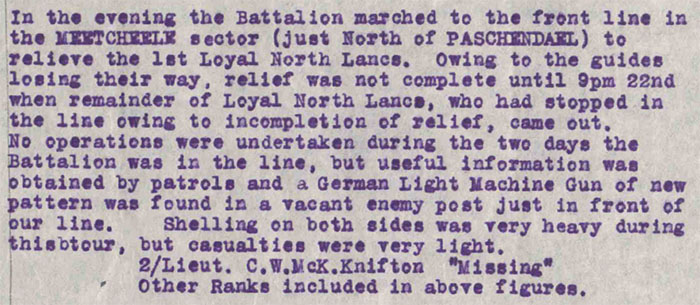 |
War Diary, Royal Sussex Regiment, 2nd Battalion
A postcard survives which has Charles' picture on the front. On the back is an appeal by his father John for information trying to locate his son. Charles was believed to have been wounded in the leg.
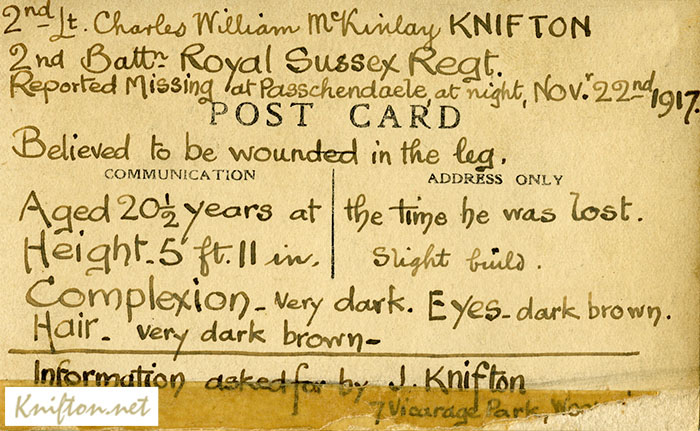 |
Second Lieutenant Charles William McKinlay Knifton was killed in action on 22nd November 1917. He was 20 years old. His younger brother James also died in action eight months later, aged 19.
Charles William McKinlay Knifton was awarded the Victory and British medals, which his father John applied for on 15th November 1921. His name is one of almost 35,000 with no known grave remembered on the Tyne Cot Memorial, Belgium. He is also named on the War Memorial at Christ's Hospital School, Horsham, and on the Woolwich War Memorial.
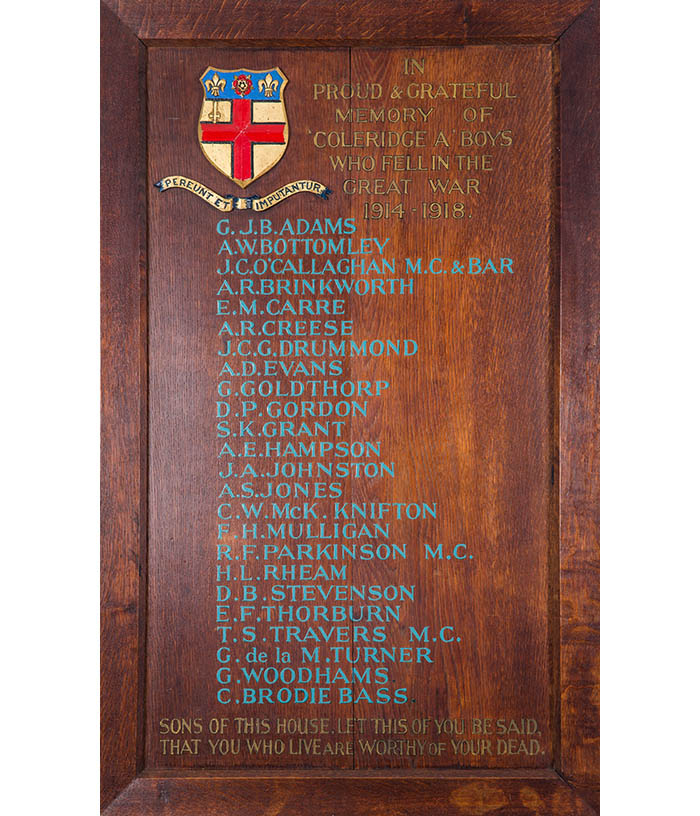 |
House Memorial, Christ's Hospital School
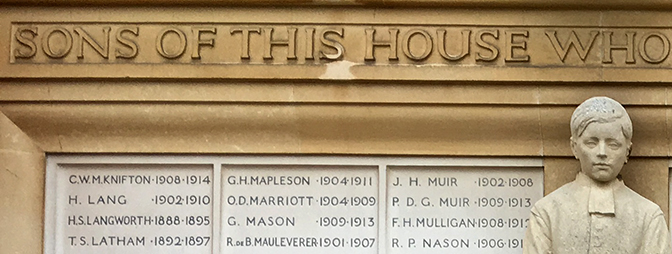 |
Dining Hall War Memorial, Christ's Hospital School
The Debt of Honour inscription on the Tyne Cot memorial reads:
IN MEMORY OF CHARLES WILLIAM MCKINLAY KNIFTON SECOND LIEUTENANT 2ND BN., ROYAL SUSSEX REGIMENT WHO DIED ON THURSDAY 22 NOVEMBER 1917. AGE 20. |
On Sunday 13th June, 1920, a special service was held at St Andrew's Presbyterian Church, Anglesea Road, Woolwich, during which a tablet which contained the names of fourteen men of the church or school who had lost their lives during the war. The tablet was unveiled by Charles' father John Knifton, and the names of both Charles and his brother James were listed.
TO THE GLORY OF GOD. THESE MEN left all that was dear to them, endured hardness, faced danger, and finally passed out of the sight of men by the path of duty and self-sacrifice; giving up their own lives that others might live in freedom: IVOR T. R. EDWARDS. PERCY FLYNN. DOUGLAS G. HAMMOND. CECIL W. HANNAFORD. WILLIAM A. HARRIS. CHARLES W. HODGIN. REGINALD JARVIS. CHARLES W. McK. KNIFTON. JAMES McK. KNIFTON. HERBERT C. LEE. GEORGE MACNAMARA. JAMES SMYTH. ERNEST E. THOMPSON. ALEC F. WRANGLE. |
Inscription on a memorial tablet originally at
St Andrew's Presbyterian Church, Anglesea Road, Woolwich
The tablet was made of brass and was located on a balcony which housed the choir and organist and so faced the congregation. The church was demolished circa 1964 and it is not known if the tablet or a photograph of it survives.
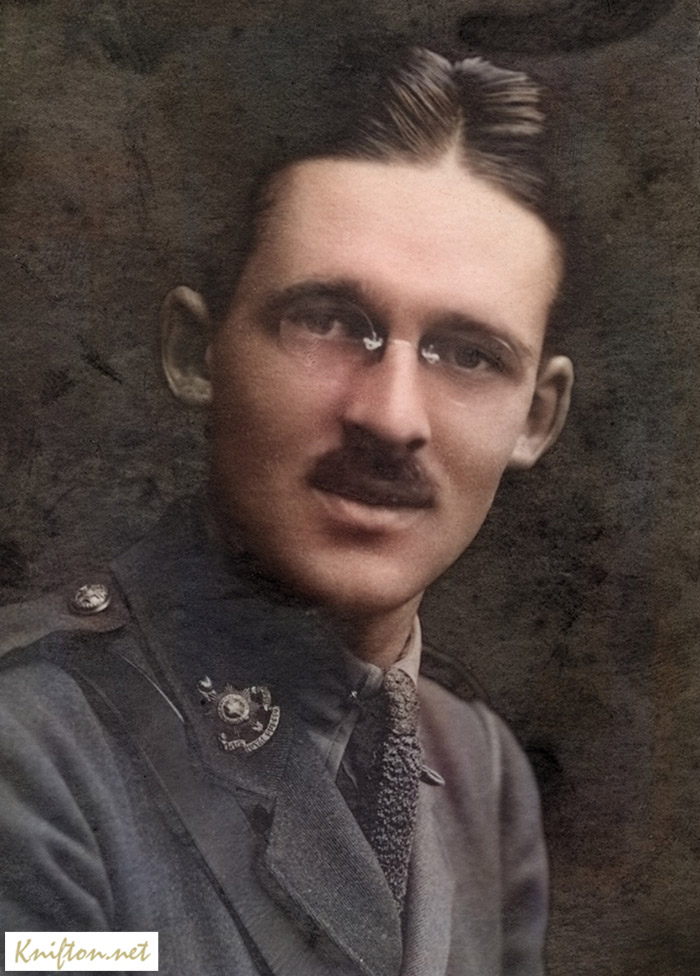 |
Charles William McKinlay Knifton 1897-1917
In memory of Second Lieutenant Charles William McKinlay Knifton 2nd BN., Royal Sussex regiment who died age 20 on Thursday 22 November 1917. Second Lieutenant Knifton, son of John and Agnes Mary Knifton, of 7, Vicarage Park, Plumstead, Woolwich, London. Served with London Scottish, Oct., 1915. Aug., 1916, when he entered Sandhurst. Commissioned April, 1917. |
Commonwealth War Graves Commission commemoration